|
|
The McKittrick Tar Pits
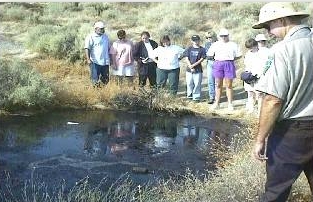 At McKittrick, along the westside of the San Joaquin Valley of California, there is a line of spectacular and richly fossiliferous tar pits that have been exploited for thousands of years. These tar pits rival the famous La Brea Tar Pits and have yielded an equally diverse assemblage of Pleistocene plants and animals. In addition, the McKittrick pits guided pioneer efforts, at the turn of the century, to develop the giant Midway-Sunset field, the largest oil-producing field in the lower 48 United States. Click on the links below to learn more about this fascinating natural wonder. At McKittrick, along the westside of the San Joaquin Valley of California, there is a line of spectacular and richly fossiliferous tar pits that have been exploited for thousands of years. These tar pits rival the famous La Brea Tar Pits and have yielded an equally diverse assemblage of Pleistocene plants and animals. In addition, the McKittrick pits guided pioneer efforts, at the turn of the century, to develop the giant Midway-Sunset field, the largest oil-producing field in the lower 48 United States. Click on the links below to learn more about this fascinating natural wonder.
| History of the Tar Pits | Geology of the Tar Pits |
You might want to check out these links as well:
| Offshore Oil Seeps | USGS Seep Page |
Geology of the McKittrick Tar Pits
|
Fossils |
Geology |
History |
Entrapment |
Climate |
 Fossils of the Tar Pits
Fossils of the Tar Pits
Although the La Brea Tar Pits are better known, the tar pits at McKittrick, on the westside of the San Joaquin Valley, contain an equally rich assemblage of ancient plants and animals that were trapped in asphalt pits and preserved as fossils. The diversity of fossils found in the tar pits is amazing and includes hundreds of plants and animals that range from pollen spores and insects to Saber-toothed Tigers and Wooly Mammoths, animals that roamed the southern California landscape during the last Pleistocene Ice Age some 10,000 to 40,000 years ago.
The bones of more than 30 kinds of Pleistocene mammals have been found in the McKittrick tar pits. Many of these fossils were excavated from 1925 to 1928. Others were collected during a dig conducted by the Kern County and Los Angeles Museums in 1949. Some of the McKittrick fossils can be seen at the Kern County Museum in Bakersfield, the West Kern Oil Museum in Taft, and the George C. Page Museum in Los Angeles.
Many of the fossil plants and animals at McKittrick are still part of the southern California landscape. But a few, particularly most of the larger mammals, did not survive drastic climate changes that came at the end of the Ice Ages. Although these animals have been extinct now for thousands of years, the McKittrick and La Brea fossils provide a remarkably complete picture of what life was like when the Ice Ages came to an end.

|
|
Geology of the Tar Pits
The McKittrick Tar Pits sit on the westside of the San Joaquin Valley where stream gravels, alluvial sands, and lacustrine clays cover older marine rocks that are rich in oil. Like most oils in California, the oil beneath the tar pits formed from bits of organic matter, called kerogen, preserved in shales of the Miocene Monterey Formation. Most of the Monterey kerogen represents the preserved bodies of microscopic organisms, such as diatoms, that live suspended in the upper few meters of the ocean. The Monterey Formation contains so many diatoms that it is known as a diatomaceous shale.
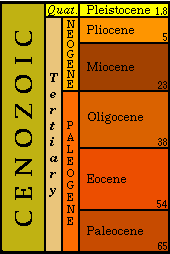 The combined effects of heat and time slowly converted the soft parts of the diatoms into liquid oil. At the same time, movements along the San Andreas fault folded and cracked the Monterey and overlying rocks to create pathways along which the oil could migrate. Some of the oil became trapped beneath a cap of Monterey Shale that appears to have slid off the mountain sides of the adjacent Temblor Range in the distant geologic past. Most of the seeps at McKittrick are found where erosion has removed the Monterey cap rock and exposed porous and permeable sandstone beds of the underlying Tulare Formation. The cross-section below shows what the geology looks like. The combined effects of heat and time slowly converted the soft parts of the diatoms into liquid oil. At the same time, movements along the San Andreas fault folded and cracked the Monterey and overlying rocks to create pathways along which the oil could migrate. Some of the oil became trapped beneath a cap of Monterey Shale that appears to have slid off the mountain sides of the adjacent Temblor Range in the distant geologic past. Most of the seeps at McKittrick are found where erosion has removed the Monterey cap rock and exposed porous and permeable sandstone beds of the underlying Tulare Formation. The cross-section below shows what the geology looks like.
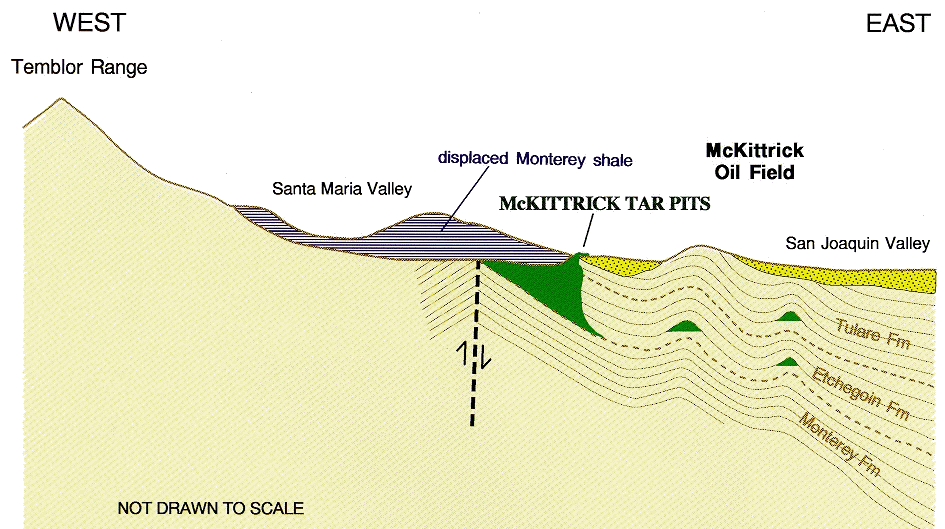
The McKittrick oils leaked up to the surface through fractures, faults, and permeable beds of sandstone. As oil seeped out into low-lying areas, shallow pools of sticky asphalt formed. These pools remain today as the oil continues to seep up just as it has for hundreds of thousands of years. Bacterial action near the surface, called biodegradation, together with evaporation and oxidation converts this liquid oil into the heavy asphaltum of the tar seeps.
|
|
Entrapment of Animals in the Tar
The heat of ancient Ice Age summers would have caused the asphalt in the tar pits to become soft and gooey. Also, there were likely times when the pits may have been hidden treacherously beneath leaves and layers of dust. Thus, animals could have easily wandered into pits by accident, and at other times they may have been chased into the pits and become stuck.
Interestingly, there are far more predators and scavengers preserved in the McKittrick and La Brea tar pits than plant-eating herbivores - more than seven carnivores to one herbivore at La Brea alone. The proportion of herbivores to carnivores in other fossil sites is more like 200 to one. The unusual preponderance of carnivores at La Brea indicates that when herbivores became trapped in the tar, they attracted hordes of carnivores, some of whom became trapped themselves. For example, one trapped horse may have attracted a few saber-toothed cats, as well as several dire wolves, some of whom also became trapped as they sought to scavange the defenseless herbivore.
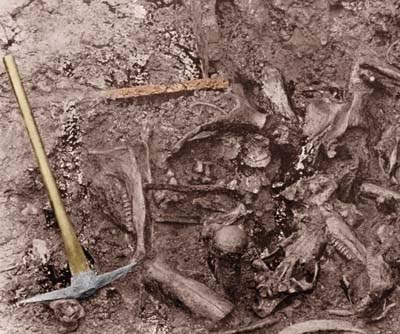 When cooler temperatures arrived during the winter, the asphalt would have hardened, making it less of a threat. Next, streams swollen with rain and laden with sediment covered the asphalt, and the animals trapped within, with sand and silt. As this cycle repeated itself, year after year for thousands of years, masses of fossil bone accumulated and were preserved in a matrix of tar and sediment. If ten animals were trapped in the pits every ten years, enough bones would accumulate over 30,000 years to account for the abundance of animals preserved in the pits. When cooler temperatures arrived during the winter, the asphalt would have hardened, making it less of a threat. Next, streams swollen with rain and laden with sediment covered the asphalt, and the animals trapped within, with sand and silt. As this cycle repeated itself, year after year for thousands of years, masses of fossil bone accumulated and were preserved in a matrix of tar and sediment. If ten animals were trapped in the pits every ten years, enough bones would accumulate over 30,000 years to account for the abundance of animals preserved in the pits.
After death, the skin, muscles, fur, feathers, and other soft parts of trapped animals decayed, whereas the bones and teeth remained intact. The bone in particular soaked up asphalt into its pores, thereby aiding in its preservation. Later, sediment brought in during the rainy season by streams and lakes rapidly buried the tar pits to prevent further decay of the asphalt-saturated bones. Unlike most fossils, those from the tar pits are unchanged, original bone material.
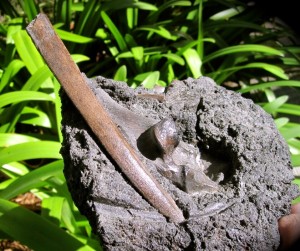
A Tule Elk rib from the tar pits
|
|
Ice Age Climate of the San Joaquin Valley
 The climate of the earth is always changing. When temperatures cooled 40,000 years ago, huge glaciers spread across large areas of North America and Europe. In California, these glaciers covered all but the highest peaks of the Sierra Nevadas. Because less free water was available, many lakes and streams in the adjacent San Joaquin Valley dried up and disappeared. In fact, so much water was locked up in the glaciers, that sea level fell, and the climate became cool and arid. The climate of the earth is always changing. When temperatures cooled 40,000 years ago, huge glaciers spread across large areas of North America and Europe. In California, these glaciers covered all but the highest peaks of the Sierra Nevadas. Because less free water was available, many lakes and streams in the adjacent San Joaquin Valley dried up and disappeared. In fact, so much water was locked up in the glaciers, that sea level fell, and the climate became cool and arid.
When the Earth warmed 30,000 years later, the glaciers melted. Huge streams formed from the glacial meltwater and rushed down the west slope of the Sierra Nevadas to turn large areas of the San Joaquin Valley into marshes and lakes. Although many of these lakes have since receded, remnants of them remain at Buena Vista Lake and Tulare Lake. Sea level also rose, and the climate became warm and humid once again. Many animals could not survive these climate changes and perished - leaving the rich fossil flora and fauna of tar pits as our best clues to what life was like in southern California during the last Ice Age.
|
|

|




 The combined effects of heat and time slowly converted the soft parts of the diatoms into liquid oil. At the same time, movements along the
The combined effects of heat and time slowly converted the soft parts of the diatoms into liquid oil. At the same time, movements along the 


 The climate of the earth is always changing. When temperatures cooled 40,000 years ago, huge glaciers spread across large areas of North America and Europe. In California, these glaciers covered all but the highest peaks of the Sierra Nevadas. Because less free water was available, many lakes and streams in the adjacent San Joaquin Valley dried up and disappeared. In fact, so much water was locked up in the glaciers, that sea level fell, and the climate became cool and arid.
The climate of the earth is always changing. When temperatures cooled 40,000 years ago, huge glaciers spread across large areas of North America and Europe. In California, these glaciers covered all but the highest peaks of the Sierra Nevadas. Because less free water was available, many lakes and streams in the adjacent San Joaquin Valley dried up and disappeared. In fact, so much water was locked up in the glaciers, that sea level fell, and the climate became cool and arid.